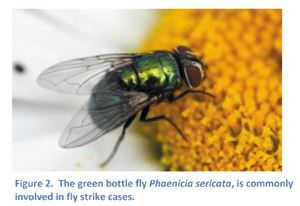Fly Strike In Calves
DR. LEE TOWNSEND
LEXINGTON, KY.
Nick Roy, ANR agent for Adair County, reported more than the usual
numbers of fly strikes to calves in his area this fall. Fly strike
begins when a female blow fly, usually metallic green bottle fly (Figure
2), lays a small batch of oblong white eggs on an attractive site.
These scavenger flies do not deposit eggs on clean dry tissue; they
select lingering wounds, accumulations of soft manure around the anus,
or tissue around a healing umbilicus. Exudates from irritated and
inflamed tissue attract more flies, compounding the problem. Although
these maggots do not feed on healthy tissue, their activity can cause
damaged tissue in the area to die. Animals are restless and may stop
feeding. Consequences include extreme discomfort, infection, and
dehydration, and in extreme cases, death of the animal.
Figure 2. The green bottle fly Phaenicia sericata, is commonly involved in fly strike cases.

Removing manure accumulations and cleaning wounds before strike can
occur is the key to preventing the problem. This is a way to approach
established strikes as well. Several fly strike products (screw worm
aerosols) containing 0.5% permethrin can be used to protect areas. Read
and follow the label directions. Contact your veterinarian in cases of
severe strike.
Green bottle flies are common insects in Kentucky. They lay their eggs
in carcasses, feces, and garbage. Large numbers of them are around by
the end of summer and they constantly move in search of places to
deposit eggs. The eggs hatch in less than a day and the maggots feed on
bacteria in these sites for 3 to 4 days before entering the soil to
pupate. Adults emerge in about 10 days to start the cycle gain.∆
DR. LEE TOWNSEND: Extension Entomologist, University of Kentucky